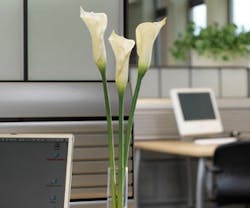Roses are red – but are they green? Flowers and plants can be beneficial for building occupants, but it’s unclear how they impact the environment. Depending on where arrangements come from and whether they’re real or artificial, they could be doing more harm than good. When considering factors like lifecycle and carbon footprint, plantings may not appear as they seem.
A frequently cited Washington State University study indicates that plants can reduce stress and improve concentration. Plants are “calming and restorative” to human well-being. But are they degenerative to the environment?
Certification for Plants
Roughly 80% of roses in the U.S. come from South America. Growing flowers in naturally warm environments abroad produces less carbon emissions than growing them domestically in artificial heat. To further promote sustainability, Colombia set up Florverde certification for its floral industry in 1996.
Drip irrigation and rain collection, hummus fertilization, and integrated pest control are among its standards. However, 20% of chemicals sprayed on Colombian flowers are illegal in the U.S., according to a 2007 study by the International Labor Rights Fund and the U.S. Labor Education in the Americas Project.
The U.S. VeriFlora Certification Standard 3.0 was developed in 2007 to address similar issues that include resource conservation, energy efficiency, ecosystem protection, and integrated waste management.
Although such standards encourage sustainable growing practices, much of the industry’s environmental damage results from transportation. Fresh-cut flowers require air freight, artificial light, and temperature control. A 2007 study by Cranfield University in England found that raising 12,000 Kenyan roses created 13,200 pounds of CO2, while the equivalent number of Dutch roses created 77,150 pounds.
Artificial Alternatives
Because silk botanicals have an indefinite shelf life, they are transported via sea and rail freight and present a viable alternative, says Tim Hennessy, managing director of Office-ScapesDirect, a designer of silk arrangements.
“The carbon footprint from transportation of fresh-cut flowers has gone beyond any consideration of being green,” Hennessy says. “Going with silk drastically reduces those emissions, even by thousands of pounds if you consider full life expectancy.”
Leasing live plants also entails service contracts that require weekly visits by vans or parcel trucks, he adds.
“Silk is virtually maintenance-free,” Hennessy notes. “It just takes occasional housekeeping with a feather duster.”
Aesthetics aren’t compromised with silk, he says, adding that housekeepers have watered their arrangements by accident and a hummingbird has hovered at the window near one.
“Silk stays beautiful for at least seven years,” Hennessy says. “Fresh-cuts are obviously perishable and need to be replaced every seven days.”
When fresh flowers die, it’s a common misconception that because they are natural, they are also biodegradable, he says. Flowers can be composted when allowed to react with air, but because modern landfills are so compacted, natural trash biodegrades anaerobically and produces methane, he adds.
“Our arrangements can be donated to Goodwill, churches, or other charitable organizations, much like clothing or furnishings,” he advises. “Even if they do end up in landfills, silk is inert so it can’t break down or produce harmful side effects.”
Another concern regarding fresh-cut plants is health-related side effects due to insects, allergens, pesticides, fertilizers, and mold and mildew from leaky pots.
“We’re designed for the indoor environment. We’re not bringing the outside in and trying to force things to prosper and grow inside; that’s not meant to be,” Hennessy says. “Plants are great for you because of the psychological benefits. So are silk plants – but they don’t have the health concerns.”
But when considering all the impacts of florals – on the environment, your health, or your pocketbook – silk deserves to be in the conversation, Hennessy says.
“For the cost of 10 or 12 months of a service contract, you could do your whole place in silk,” he adds. “We’re all about environmental and financial stability.”
Chris Curtland ([email protected]) is assistant editor of BUILDINGS.
